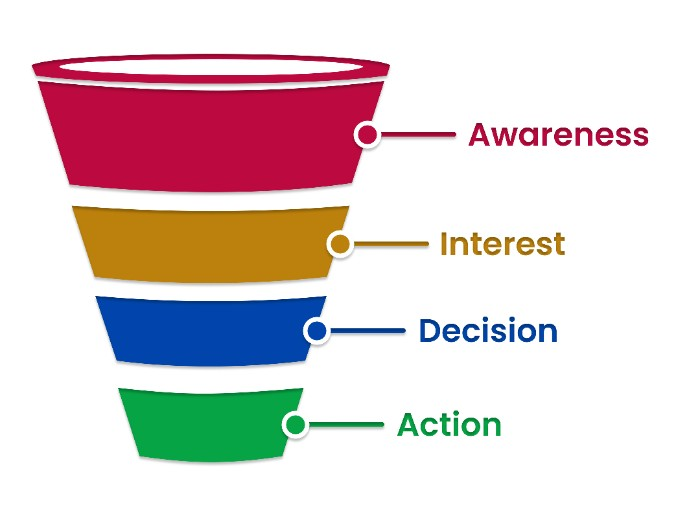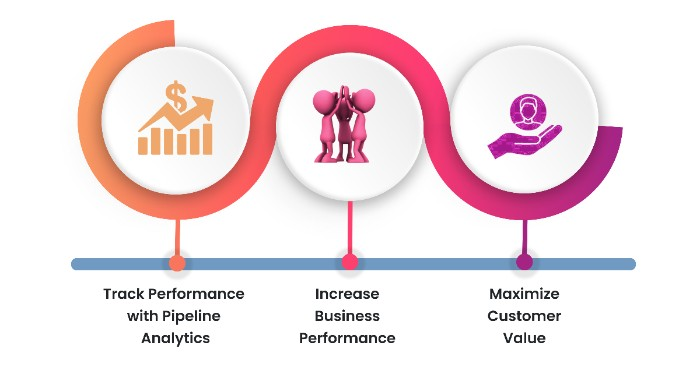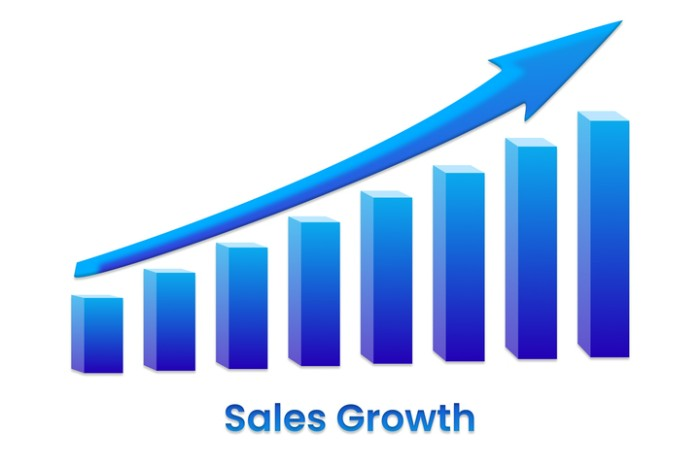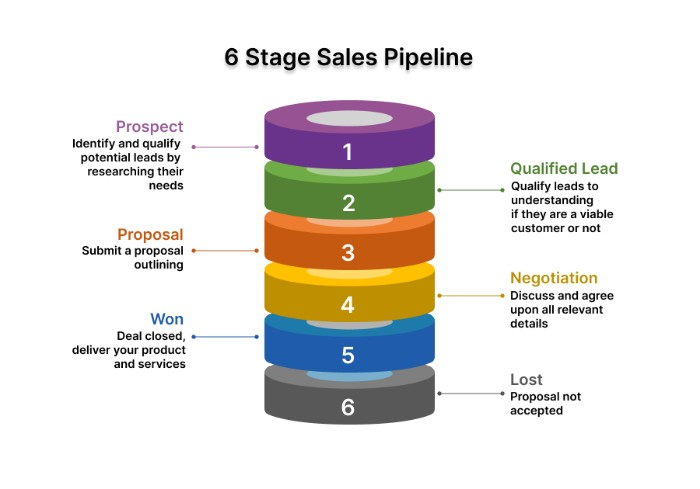A business owner’s effective sales pipeline is vital to ensuring long-term success. Consolidating customer data and automating everyday tasks with a Customer Relationship Management (CRM) solution can help you build and maintain a competitive sales pipeline quickly and efficiently. CRMs are powerful tools that help businesses streamline operations, increase efficiency, maximize growth opportunities, and more—all of which can have meaningful bottom-line results for your organization.
In this blog post, we’ll cover essential strategies for creating an efficient sales pipeline with the help of a CRM system so that you can start realizing the full benefits of CRM technology today!

What exactly are sales pipelines?
You’ve probably heard of sales pipelines if you’re a business owner. But what exactly are they? In short, a sales pipeline is a series of steps a salesperson takes to move a prospective customer from awareness to purchase. In addition, the sales pipeline helps in the sales forecast.
Every day, the sales team must be able to track how many offers they are pursuing. Number of deals in pipeline = number of qualified opportunities within the pipeline.
Here are a few steps to make you understand the sales pipelines effectively:

Problem: As a business owner, keeping track of the sales process and ensuring your team stays on target for success can take time and effort.
Agitate: With a clear understanding of how each customer moves through the pipeline, you could save time and resources chasing leads that are likely to convert. And if you have visibility into where customers are in their journey, it’s possible to know what strategies need adjusting or which should be implemented.
Solution: A visual representation of your sales pipeline with CRM software can help you gain valuable insights into customer behavior and identify areas for improvement so that you can refine your strategy accordingly. With the right tools in place, you’ll be able to streamline operations, increase efficiency, and maximize growth opportunities—all while ensuring long-term success for your organization!
Sales pipelines vary in length and complexity but typically include stages such as leads (potential customers who have been identified), nurturing (building relationships with potential customers), and closing (converting potential customers into paying customers).
Sales pipelines are an invaluable tool for sales managers. With the help of a CRM, sales managers can easily analyze customer data to track team performance and understand customer trends that may affect overall success. Sales pipelines help sales reps to stay organized and more productive. With the help of a CRM, tasks can be automated, customer data can be tracked and analyzed, and reps can easily keep tabs on their performance against goals.
Further, we’ll take a closer look at sales pipelines and how they can help your business boost its bottom line. Stay tuned!
Why do you need sales pipeline software?

Sales pipeline applications can be utilized to track sales growth. The deal is apparent. Also, be clear on exactly how to plug holes to avoid misunderstanding. CRM sales pipeline software also identifies the transactions which require a lot more attention. A sales pipeline helps your sales reps understand the sales process in your company. An increase in sales conversions necessitates that you must follow a well-defined pipeline for the entire sales process.
Sales pipeline software helps to streamline the sales process, reduce paperwork and maintain accurate records. It gives excellent insight into your team’s performance, customer trends, and overall success with detailed reports and dashboards. With this information in hand, companies can make accurate predictions, develop better marketing strategies, and make well-informed decisions to maximize their revenue.
In conclusion, sales pipeline management software is an invaluable tool for any business wanting to stay ahead of the competition and increase profits. With its powerful data insights, automation capabilities, and improved team performance monitoring features, you can gain greater control over your entire data-driven decisions to refine your sales strategy and maximize ROI.
Sales pipeline software also helps improve communication between teams, managers, and customers by allowing team members to easily access customer data in one place. It also makes it easier for reps to track individual rep performance against goals, identify strengths and weaknesses, and ensure that everyone is working together to achieve a common goal. With the help of CRM software, businesses can easily optimize their sales process and stay on track for success.
By leveraging the full benefits of CRM technology today, you can ensure that your sales reps have access to all the tools that are essential to succeed in closing deals quickly and efficiently.
The Several Benefits of Sales Pipeline

Studies show that those companies that implement formal sales processes can expect to see a significant boost in their revenue growth. In fact, one survey revealed much difference in revenue growth between the companies that had a uniform sales process and those that did not.
Sales pipeline software is an invaluable tool for businesses looking to increase their profit margins. Not only does it provide valuable information but it also streamlines the complex sales process, automates tasks such as lead generation and follow-up, and optimizes the entire process to ensure a smooth and efficient workflow.
Keep track of sales progress.
Keeping track of sales progress is an important part of any sales process, as it gives insight into how the sales cycle, multiple sales pipelines, and ongoing sales activities are performing. This can help to determine how many deals have been closed or are still in progress. Analyzing sales progress enables salespeople to make sound decisions so they can better prioritize their time, maximize effort, and optimize their sales efforts accordingly. Ultimately, this will drive an increase in sales success and keep operations running efficiently.
Keeping track of the sales pipeline allows you to set up accurate sales forecasts and measure the performance of your sales team by providing an overview of how far along each deal is in the sales cycle. It also provides insights into which deals are likely to close and makes sure that sales goals are being met on time. Having this information can help to improve team morale, uncover hidden opportunities, and boost revenue.

Sales pipeline software can be a powerful tool for businesses that want to be sure they are following their sales cycle correctly, tracking progress accurately, and optimizing their sales process effectively. With the right CRM in place, companies can confidently manage their sales process and maximize their profits.
Appropriate Resource Allocation
Appropriate resource allocation is essential in sales. A sales cycle generally has multiple sales pipelines that need to be managed and monitored effectively to ensure success. It is important to analyze how many deals are going through at any given time, as well as the sales activities that need to take place per each sales pipeline. Knowing when and where resources should be directed can make a big difference in closing big sales and keeping the sales team motivated. Having the details about what works best can go a long way, especially when making decisions about allocating your sales resources.
A marketing team should be focused on developing sales strategies and supporting the sales professionals in delivering the desired results. Time and resources should be invested in marketing tools and techniques to target prospective customers more accurately, with a focus on efficiency and increased outreach.
Track sales
Tracking sales in sales pipelines is a powerful way to manage sales efforts and ensure sales targets are achieved. A sales pipeline can break down sales into stages, from initial lead qualification through to closing the deal. This helps visualize sales, set goals, and measure success all in one place. By using sales pipelines effectively, organizations can track sales progress, identify opportunities for improvement, and maximize their sales return on investment.
Improving forecasting revenue

Having accurate sales forecast revenue can be the difference between success and failure for businesses. With details of the leads placed in the pipeline, it is made easier to forecast whether those deals will close or not, along with how much revenue each deal could generate.
The total sales deal sum represents the sales pipeline value. Pipelines can help you forecast future revenue.
Knowing exactly where the sales team stands on its targets allows for strategies to be tailored to make sure company goals are reached on time. It also allows managers to see which stages need more resources or if sales strategies should be changed to close more deals. Understanding forecast revenue enables a business to remain competitive in its field while maximizing profits every period.
Improve sales visibility
Improving sales visibility helps businesses to gain a clear understanding of conversion rates and pipeline value, as well as enables them to track any adjustments necessary to reach their desired sales quota. By optimizing conversion rates and capturing important data, it is possible to uncover new growth opportunities and more accurately forecast future performance.
Additionally, this can help businesses understand the entire sales cycle better, from leads to conversion, allowing them to ultimately make better decisions when it comes to setting targets and reaching goals.
Understanding the Different Sales Pipeline Stages
Staying on top of the sales pipeline is a critical part of running any successful business – understanding where you stand in different stages, how many deals are in play at one time, and mapping out your progress and potential wins can prepare you for success.
Whether you run a small business or an enterprise-level operation, understanding the different sales pipeline stages is paramount to uncovering the hidden potential within your organization. Visualizing this information can help simplify complex decisions while providing clarity into key performance metrics such as average deal size and close rate. Further, we will dive deep into the various typical sales pipeline stages from start to finish so that you’ll have all the knowledge needed to maximize your selling efforts!

Prospecting.
Prospecting is the first step in any successful sales pipeline. Here, you’ll need to identify and qualify potential leads by researching their needs, interests, and budget. Once identified, you can then reach out with offers that best match their needs and build relationships with them.
Lead management involves tracking and managing prospects to ensure potential leads are nurtured until they become customers. This includes researching competitors, monitoring customer feedback, and creating offers that will be attractive to them.
Qualified lead.
After identifying a potential lead, it’s important to qualify them further so you can understand if they are a viable customer or not. This could include understanding their budget, seeing if they have the necessary authority to make a decision, and evaluating their timeline for making a purchase.
Once qualified, it’s time to engage your sales-qualified leads with content that reflects their interests and motivates them to make a purchase.
Proposal.

After all the prior steps have been completed, it’s time to submit a proposal outlining your solution and how it solves your problem. This is where you’ll need to make sure that you focus on value rather than just features. And put together all the information gathered during the prospecting and qualification stages so that they can make an informed decision. Additionally, be sure to include any special offers or discounts that could further motivate them to purchase.
Negotiation
Once a deal is accepted, and you have built a relationship with your leads and provided them with valuable content then the sales process enters its final stage: negotiation. Here, you’ll need to make sure that all relevant details are discussed and agreed upon. This could include payment terms, product features and benefits, the timeline for delivery, after-sale support, and any other pertinent information. Once both parties have signed off on the agreement, the deal can then be considered closed.
Won

Once you have closed the deal, it is time to celebrate! This is when your hard work has paid off and your customer will enjoy the benefits of your product or service. It’s important to make sure that you deliver on any promises made during the negotiation stage, as this could impact future sales opportunities with similar customers.
Lost

Unfortunately, not every proposal will be accepted and often deals won’t close. This happens for several reasons such as budget restrictions or changes in customer needs. Whatever the case may be, it’s important to keep track of canceled proposals so you can better understand why they weren’t successful and use this data to improve your sales process in the future.
By understanding and visualizing the different sales pipeline stages, you can better understand how to increase your close rate, maximize deal sizes, and shorten the time it takes for deals to close.
Building Effective Sales Pipelines
Building an effective sales pipeline requires a combination of time, effort, and strategy. By utilizing the right tools and processes, you can make sure that each stage is managed efficiently and that your leads are nurtured through to a successful sale. With the right approach in place, you can increase your chance of closing more deals while minimizing wasted time and resources.

By staying organized and tracking your sales pipeline, you will be able to identify any weak points or bottlenecks in the process so that they can be corrected or improved. Additionally, by monitoring the performance of specific sale rep, you can provide feedback on their performance and help them hone their skills. With a well-managed sales pipeline, you can maximize your sales team’s efficiency and increase the overall success of your business.
Following are the steps to build effective sales pipelines
Determine the structure of your pipeline. (Based on your business)
Creating a sales pipeline structure is essential to ensure sales team efficiency. The number of deals, deadlines, and the organizational structure of your sales pipeline should all be taken into account during the development process. Furthermore, a sales pipeline management system should be both comprehensive and visual, allowing sales teams to effectively forecast meaningful performance metrics such as revenue growth, sales goals, and conversion rate over time.

With accurate sales data to inform decision-making processes, sales teams can track progress and discover areas for improvement as they strive toward sales success.
Create Custom Pipeline
Creating a customized pipeline can help the sales team reach their maximum revenue goals. By taking the average sales cycle length and deal stages into consideration, you can tailor pipeline steps that are specific to your business unit. This will allow for a streamlined workflow and faster conversion time as well as a clear picture that could be used for future ventures.
Identify your leads

An essential part of any business’s success is identifying new leads and potential customers. By collecting customer data, businesses can start the process of lead nurturing and begin scoring new leads based on the criteria that best describe who will become a long-term customer. This enables businesses to prioritize their customer base and focus resources where they are most needed: increasing new leads and fostering customer loyalty.
Add leads to the appropriate stage
Once leads have been identified and scored, they should be added to the appropriate stage of the sales pipeline. This will allow salespeople to focus on more qualified leads and work towards closing deals more quickly. Additionally, each lead’s progress through the pipeline must be tracked so that any potential issues can be addressed quickly.
Schedule sales events in conjunction with each stage
Sales teams can ensure success by organizing sales events in conjunction with each stage of the sales process. Scheduling sales events at the beginning and end of sales cycles allows sales team members to predict revenue, review sales data, and monitor conversion rates more efficiently. By aligning sales processes with sales events, teams can better track performance and identify areas for improvement. Not only does it provide valuable feedback on how to create successful sales strategies going forward, but it also acts as an incentive to keep sales team members on their toes.
Keep your pipeline well organized
The organization is key when it comes to managing your sales pipeline. A well-maintained and organized pipeline helps sales teams quickly identify leads, deal size, and other key information needed to make informed decisions. Additionally, a well-organized pipeline also encourages collaboration between departments as they review data together and optimize the system for even better results.
Keeping track of your sales pipeline

Keeping track of the sales pipeline is essential for sales teams to reach their optimal performance. With the right strategies and tools, businesses can ensure that all the necessary steps are taken to maximize efficiency and increase overall success.
By considering these steps, you can create an effective sales pipeline that will help improve sales performance and increase revenue. With an improved system, businesses can better track their leads, and several deals and close more deals while staying organized and efficient in the process.
The success of any business depends on its ability to manage the sales pipeline effectively. By taking into consideration the different stages and strategies involved, businesses can create a comprehensive system that will help teams reach their goals.
Follow the most promising leads.

Once leads have been identified and scored, it is important to focus on the most appropriate ones. This can help sales teams prioritize their time and resources so that they are targeting qualified customers instead of wasting energy pursuing leads that may not convert. By focusing on the most promising leads, sales teams can increase their conversion rate and close deals faster.
End the deals that are no longer viable

To maximize efficiency, sales teams should also be quick to identify and end deals that are no longer viable. This will help them save time and resources by focusing on leads that have a higher chance of conversion. Additionally, this allows businesses to reallocate their efforts to more promising opportunities thereby meeting sales targets instead of spending time on dead-end leads.
Check the statistics and results of the pipeline

The pipeline should be monitored regularly to ensure that it is running efficiently and that all the necessary steps are being taken to maximize success. By reviewing conversion rates, the number of deals, and other key metrics, businesses can better understand how their sales processes are performing and identify areas for improvement. This will allow them to make changes quickly and ensure that they are always working towards achieving the best possible results.
In conclusion, following the right strategies when managing your sales pipeline will help you stay organized and efficient while maximizing success.
Sales pipelines should be regularly updated.
By staying on top of the data and trends, businesses can better track customer journeys and optimize sales processes(in the sales cycle) to increase revenue. Additionally, this will help teams stay informed of their performance so they can make changes quickly when needed to maximize success.
Effective sales pipeline management software is essential for any business that wants to succeed.
Maintain a short sales cycle.
Considering the sales cycle length is crucial. Having a shorter sales cycle will help businesses close deals faster, freeing up resources for other tasks. Additionally, this will allow teams to focus on more qualified leads and increase the conversion rate. By maintaining a shorter sales cycle length, businesses can ensure that their teams are taking the necessary steps to reach their goals while staying organized and efficient in the process.
Regular training and education are essential for improving sales performance.
By providing regular training and education to sales teams, businesses can ensure that their team members are fully informed of the latest strategies and techniques so they can maximize success.
Choose the right CRM for sales pipeline management.
By using the right CRM system, businesses can better track leads and measure performance. By utilizing the data from their CRM system, teams can adjust strategies quickly to maximize success and effectively predict revenue. Additionally, this allows businesses to automate some processes and take a more strategic approach when it comes to sales pipeline management.
EQUP is one of the most effective customer relationship management (CRM) suites available today and the best sales pipeline software. It is also capable of facilitating the creation of customized pipelines based on your business industry(SAAS, Service, E-commerce) and needs.
In conclusion, managing a successful pipeline requires effort and strategy. By following the right steps and utilizing the right tools, businesses can ensure that their sales team is organized, efficient, and successful.
Successfully close more deals by streamlining your sales process.

By investing time in researching, prospecting, and qualifying leads, you can identify those who are more likely to convert into customers. Additionally, by providing content that reflects their needs and interests, as well as offering discounts or special offers, you can increase the likelihood of success. After all the necessary steps have been taken, you can then start to negotiate and close the deal. Finally, once a successful sale has been made, celebrate your success and make sure to learn from any losses. With these tips in mind, you will be well on your way to creating an effective sales pipeline!
Wrapping up
Above all though, developing an effective sales pipeline and ensuring that it is well-managed can be a difficult undertaking. You must choose the right CRM software and develop strategies to effectively manage your team members. Hopefully, this blog post has given you some insight into how creating and managing a sales pipeline can benefit your business’s relationship with customers in the long run. And with the help of the best CRM software on the market, you are ready to go! So don’t wait; click here to get the most effective and affordable sales pipeline management software and reach your goals today!